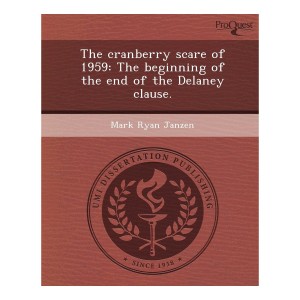InThePastLane by Edward T. O’Donnell
 What’s Thanksgiving without cranberry sauce and cranberry bread? In 1959, millions of Americans found out. The problem was not with the cranberry supply, for growers had reported an excellent harvest that year. Rather, Americans were responding to a recommendation from the Secretary of Health, Education, and Welfare to avoid cranberries because tests had revealed small traces of a cancer-causing pesticide in some supplies. The warning ultimately proved unwarranted, but not before Americans endured the first in a succession of scares over chemicals in the food supply and the cranberry industry suffered losses in the millions. The hysteria marked the first of many food scares in the U.S. brought on by rising fears of threats posed to the environment and food supply by pesticides and other dangerous chemicals.
What’s Thanksgiving without cranberry sauce and cranberry bread? In 1959, millions of Americans found out. The problem was not with the cranberry supply, for growers had reported an excellent harvest that year. Rather, Americans were responding to a recommendation from the Secretary of Health, Education, and Welfare to avoid cranberries because tests had revealed small traces of a cancer-causing pesticide in some supplies. The warning ultimately proved unwarranted, but not before Americans endured the first in a succession of scares over chemicals in the food supply and the cranberry industry suffered losses in the millions. The hysteria marked the first of many food scares in the U.S. brought on by rising fears of threats posed to the environment and food supply by pesticides and other dangerous chemicals.
The cranberry harvest of 1959 was one for the record books, coming in just under 125 million pounds. The vast majority of it was destined for cranberry sauce, most of which sold in November and December for Thanksgiving, Christmas, and New Year’s dinners. Growers were anticipating record sales when disaster struck.
In early November, Arthur S. Fleming, Secretary of Secretary of Health, Education, and Welfare, issued a warning to consumers that traces of the weed killer aminotriazole had been found in Oregon and Washington State. He urged Americans to “be on the safe side” and avoid consuming cranberries until the crop had been tested and deemed safe. Given the time required to carry out such testing, he all but guaranteed that the sale of cranberry products for 1959 would crash to historic lows.

Arthur S. Fleming, Secretary of Secretary of Health, Education, and Welfare, triggered the Great Cranberry Scare of 1959 by urging American consumers to avoid cranberries and cranberry products.
Fleming was motivated to make this announcement by his reading (incorrect, as it turned out) of a provision (the so-called Delaney Clause) in the 1958 Food, Drug and Cosmetic Act of 1958 that prohibited the sale of any food shown to contain cancer-causing chemicals in humans or lab animals. In the coming decades the Delaney Clause would be celebrated by many consumer advocates and environmentalists as one of the most important early federal health regulations. Unfortunately, its first invocation in the cranberry scare of 1959 produced only panic for the public and near financial ruin for cranberry growers.
To begin with, the pesticide was found in Washington and Oregon, states producing only a fraction of the national crop. Secretary Fleming clearly overreacted in making a blanket statement urging Americans to avoid cranberry products. In addition, Fleming misread the Delaney Clause which prohibited the sale of food products containing dangerous chemicals. Fleming sounded the alarm when pesticides were found only in raw harvested cranberries, not cranberry juice or sauce. Finally, later research showed that the amount of pesticide found was miniscule.
Understandably, the cranberry industry was furious. The executive vice-president of Ocean Spray held a press conference and read a telegram he’d sent earlier that day to Secretary Fleming: “We demand that you take immediate steps to rectify the incalculable damages caused by your ill-formed and ill-advised press statements yesterday. You are killing a thoroughbred in order to destroy a flea. You must know that there is not a shred of evidence that a single human being has been adversely affected by eating allegedly contaminated cranberries.”
But the damage was done. On November 15, the New York Times reported that, “Some communities have banned the sale of all cranberry products, numerous large grocery chains have removed the products from their shelves and many restaurants have dropped cranberries in any form from their menus.” Cranberry growers, nearly all of them small family farmers, lost millions of dollars.
 The Great Cranberry Scare lasted only one season and the industry, with nearly $10 million in compensation payments from Congress to make amends for the government’s mishandling of the incident, saw sales rise to normal levels the next year. But the fear in the general public over carcinogens and other harmful chemicals in the food supply would never go away. Indeed, they would only grow in the coming decades with the publication of Rachel Carson’s famous book, Silent Spring (1962), the founding of numerous environmental, public health, and consumer protection organizations, and occasional scares like that in 1989 over Alar in apples.
The Great Cranberry Scare lasted only one season and the industry, with nearly $10 million in compensation payments from Congress to make amends for the government’s mishandling of the incident, saw sales rise to normal levels the next year. But the fear in the general public over carcinogens and other harmful chemicals in the food supply would never go away. Indeed, they would only grow in the coming decades with the publication of Rachel Carson’s famous book, Silent Spring (1962), the founding of numerous environmental, public health, and consumer protection organizations, and occasional scares like that in 1989 over Alar in apples.
Happy Thanksgiving!

